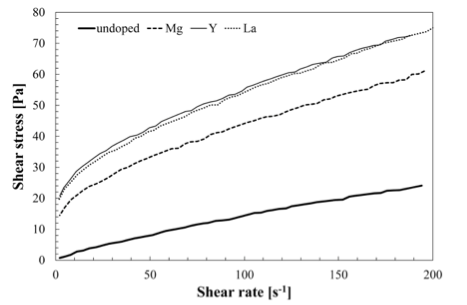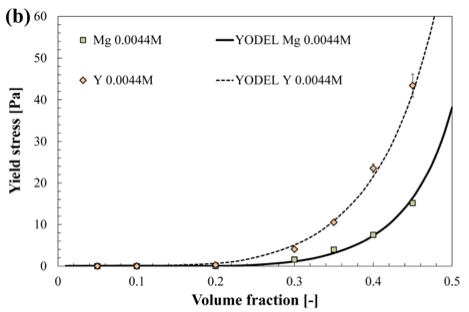Rheology of powder suspensions is a key factor in many processing routes, and better understanding of the parameters that control the rheology improves technical progress by reducing the empirical factors in the formulation of powder slurries [1].
The strict requirements for the production of transparent polycrystalline alumina demand a fundamental understanding of powder handling and processing steps. The use of dopants (Mg, Y, La) has proven useful, but produce noticeable effects on suspension rheology and influence the choice of the processing route [2].
|
|
|
| Effect of dopant addition on rheology of aluminas suspension for freeze granulation [1] |
Experimental and model yield stress curves as function of the powder volume fraction. For Mg2+ and Y3+ at 0.0044 M [1] |
With the goal of spray granulation the rheological behavior of doped alumina suspensions was investigated from a fundamental approach taking into account slurry and particle characteristics by computing the inter-particle potentials. The information provided by the inter-particle interactions was then used in a yield stress model for concentrated suspensions (YODEL) [1] which successfully predicted the rheological behavior of the doped alumina slurries from basic powder parameters (e.g. particle size, zeta potential, solid fraction, Hamaker constant) [2]. This allowed a dispersion strategy to be developed that allowed successful freeze granulation and dry processing of transparent aluminas for the first time [4]. The combination of interparticle force modelling and the YODEL yield stress model has also been successful in predicting the behaviour of environmentally friendly cementitious materials [3] (see Cementitious materials – Superplasticizers).
References :
1. M. Stuer and P. Bowen, “Yield stress modelling of doped alumina suspensions for applications in freeze granulation: towards dry pressed transparent ceramics” Advances in Applied Ceramics 111(5/6) 254-261, 2012 DOI 10.1179/1743676111Y.0000000061
2. Powder Technology 157 (2005) 100-107
3. U. Aschauer, O. Burgos-Montes, R. Moreno, P. Bowen, “Hamaker 2: A toolkit for the calculation of particle interactions and suspension stability and its application to mullite synthesis by colloidal method”. J Dispersion Science Technology, 32(4), (2011), 470 – 479. (http://hamaker.epfl.ch)
4.R. J. Flatt, P. Bowen, “YODEL: a Yield stress mODEL for suspensions” J.Amer.Ceram.Soc., 89(4) 1244-56, (2006)

